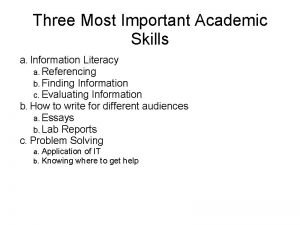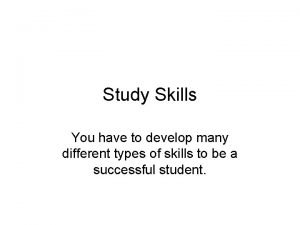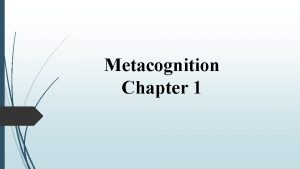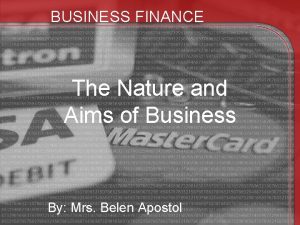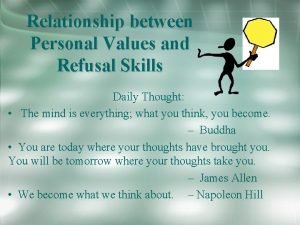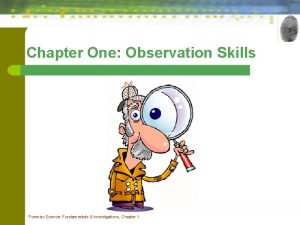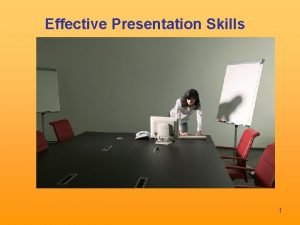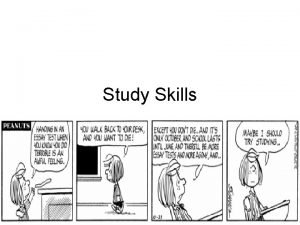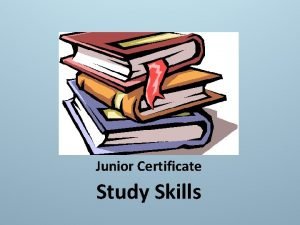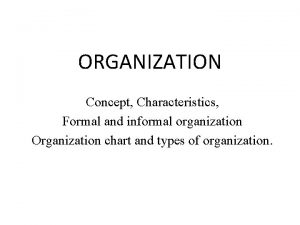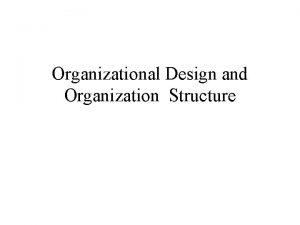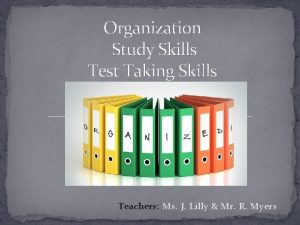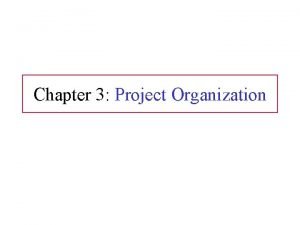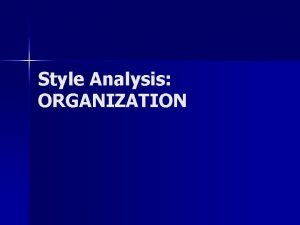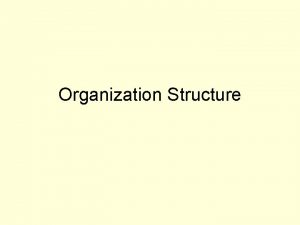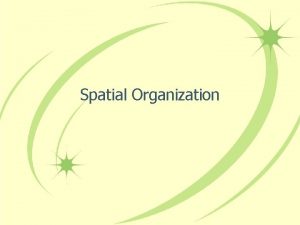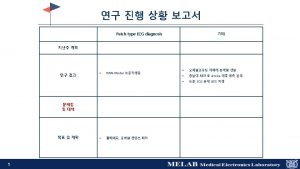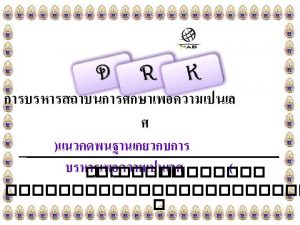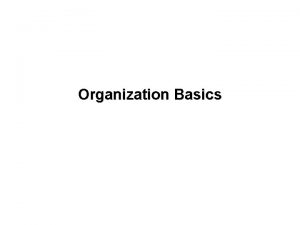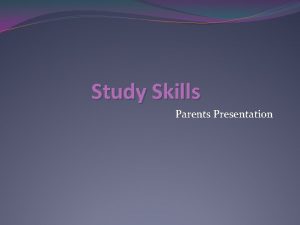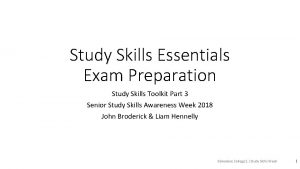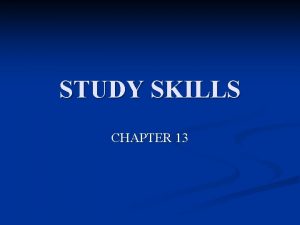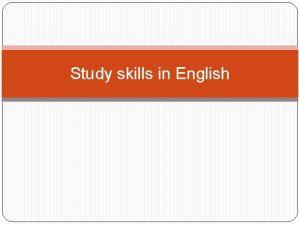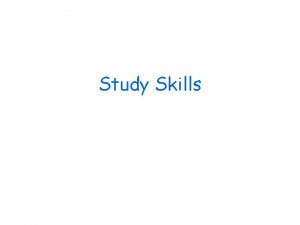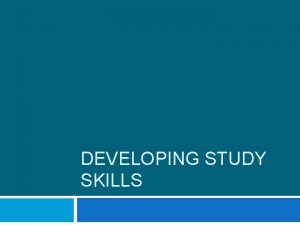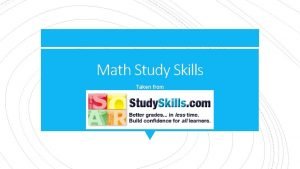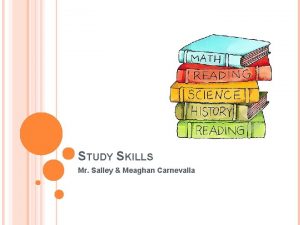Study Skills And Organization Why Study Skills This






























- Slides: 30

Study Skills And Organization ,

Why Study Skills? • This class will help all students overcome study issues and identify common study problems. • Students will get an opportunity to work on their own subjects with practical assignments.

Learning is an active process. 1. If you don’t participate in learning, you will not be successful. 2. Each step in the learning process takes effort on your part.

• Do you, as a student: 1. 2. 3. 4. 5. 6. Have goals you want to achieve? Know how to study? Understand your learning style? Understand time management? Use a calendar or planner? Plan to attend all classes?

7. Maintain an organized notebook or binder? 8. Know how to take notes? 9. Read the text books effectively? 10. Memorize class material and are able to recall it for tests? 11. Take tests successfully?

What is covered in these sessions? • Goal Setting 1. 2. • Effective Study Habits 1. 2. 3. • Visual Auditory Kinesthetic Time Management 1. 2. • When Where How much, daily Identify Your Learning Style 1. 2. 3. • What YOU want How to ACHIEVE it Use a planner or calendar Attend all classes Organization 1. 2. Notebook or Binder Tabs • Critical Thinking • Taking Notes 1. 2. 3. How to take notes What to listen for How to use your notes • Read a Text Book 1. 2. 3. Reading speed Skimming Scanning • Memorization 1. 2. How to effectively memorize material Mnemonic aides • Test Taking 1. 2. 3. 4. True/False Multiple Choice Fill-in-the-Blank Essay

THE HANDOUT JOT NOTING & RECORDING KEY POINTS

Goals • Honours • High school graduation • University • College • Workplace entry

Goal Setting • What do YOU want? A goal is something you want to achieve. It can be either short-term or long-term. • Short-term goal - something you want to achieve soon. 1. Set short-term goals for yourself • • • Today This week This month • Long-term goals – something you want to achieve in the distant future. 1. Set long-term goals for yourself • • • Finish high school Mun entrance Degree

Characteristics of Appropriate Goals • Your goals should be: 1. within your skills and abilities. – Knowing your strengths and weaknesses will help you set goals you can accomplish. 2. realistic. – Setting a goal to learn the spelling of three new words a day is realistic. Trying to learn the spelling of fifty new words a day is not. 3. flexible. – Sometimes things will not go the way you anticipate, and you may need to change your goal. Stay flexible, so when you realize a change is necessary, you will be ready to make the change. 4. measurable. – It is important to be able to measure your progress toward a goal. It is especially important to recognize when you have accomplished your goal and need to go no further. Failure to measure your progress toward a goal will result in effort that is wasted. 5. within your control. – Other than when working as part of a group, accomplishment of your goal should depend only on you. You can control what you do, but have little or no control over what others do. You may do what you have to do, but others don’t and they may cause you to not accomplish your goal.

Let’s Set Some Goals! To set a goal, you should state WHAT you will do and WHEN you will do it. Implied in each goal is your WILL(determination) to do it. • Short-term Goals Today, Tomorrow, This Month… • • • Goal 1 - ________________________________ Goal 2 - _____________________________ Goal 3 - _____________________________ • Long-term Goals GED, Job, Car, House, College, etc. • • • Goal Goal 1 2 3 4 5 - __________________________________________________________ - _____________________________ – _____________________________

How do I get there from here? • Set Goals and Update Often 1. Goals must be updated often. 2. Some may take more time than you planned, so don’t give up! 3. When goals are accomplished, add new ones. • Seek Support 1. 2. 3. 4. Friends Teachers Guidance Parents

It’s Study Time!

Effective Study Habits • Study Time: 1. Find a place to study that is best for you. Consider whether you it is best for you to be away from people, if noise will bother you, and the way the light effects your studying. 2. Have everything you need to study, nearby while you study. This will save time when you don’t have to hunt for equipment and materials. 3. Reward yourself for hard work. Set a goal for the work time. When you achieve it, reward yourself with something you like. Some examples are: food, TV time, video games, phone time, etc. 4. Create a checklist of all the tasks you need to do before you begin to study. Prioritize these tasks starting with the most important tasks to be done. Check each item off as you complete it. This gives you a sense of accomplishment. 5. Keep a “worry pad” while you study. Write down anything that distracts you. These are things that pop into your head while you study. Each time a worry interrupts your studying, write it on the pad to be completed later.

Procrastination! • What is procrastination? – Putting off or avoiding to do something that must be done. v Its natural to procrastinate occasionally. However, excessive procrastination can result in guilt feelings and anxiety about not doing a task when it should be done. v Procrastination can interfere with school and personal success. • Why do students procrastinate? 1. 2. 3. 4. 5. 6. 7. 8. Perfectionism Fear of Failure Confusion Poor Motivation Task Difficulty Concentrating Task Unpleasantness Lack of priorities

How to Eliminate procrastination! • Motivate yourself to work on a task. Tell yourself things such as: “There’s no time like the present. ” or “The quicker I start, the quicker I’m finished. ” • Prioritize the tasks you have to do. • Commit your self to completing a task once you’ve started it. • Reward yourself when the task is complete. • Work on tasks at the times you work best. • Break large tasks down into small, manageable parts. • Make a schedule of the tasks you have to do and stick to it. • Work on the smaller tasks first. This leaves more time for the difficult and time consuming tasks. • Find a good place to work that is free of distractions. • Take breaks when working on a task so you don’t wear down.

Use a Study System 1. Break large assignments, such as essays or research papers, into smaller tasks. Schedule those tasks our over several days, depending on when the completed assignments are due. 2. Study least difficult subjects first. This will eliminate so many tasks hanging over your head, and give you a sense of accomplishment when they are finished. It also give you more time for the more difficult, time consuming tasks. 3. Take breaks. Don’t try to study for several hours straight! You’ll become distracted, tired, and cranky. Take a short break, about 5 minutes, every hour. This will allow you to relax and be alert. 4. Reward yourself. When you complete a task, especially a difficult one, give yourself a reward such as a healthy snack, phone a friend, or listen to music. Then get back to work. 5. Study from YOUR OWN textbooks! Do Not share books with a friend. You may have a difficult time having the book enough to properly study the material.

I like your Learning Style! Visual Auditory Tactile

Discover and Use Your Learning Style Discovering and using your learning style is the key to successful learning. Like everything else about you, your learning style is uniquely your own, different from anyone else’s. It is the conditions under which you find it easiest and most pleasant to learn and work.

VISUAL Learner • Prefer visual sense. • Must see to understand. • Learns best by reading and watching.

AUDITORY Learner • Prefers auditory sense. • Must hear to understand. • Learns best by listening to an explanation.

TACTILE Learner • Prefers tactile sense. • Must touch or feel to understand. • Learns best by engaging in hands-on activity.

REFER TO YOUR HANDOUT CHECK THE ONES YOU PREFER & X THE ONES YOU DO NOT PREFER

What are your learning preferences? 1. 2. 3. 4. 5. 6. 7. 8. I learn best by reading on my own. I get the best results from listening to lectures. I enjoy courses where there is some physical activity. I can learn how to do something by watching a demonstration of how it’s done. Class discussions are helpful to me. I like to type and to use the computer. Illustrations, charts, and diagrams improve my understanding. I’d rather listen to the teacher’s explanation than to do the assigned reading.

9. I get more out of lab classes than lectures because of the hands-on approach. 10. How-to manuals and printed directions are helpful to me. 11. I like to use audio lessons and exercises. 12. I’d rather work with machines and equipment than listen to or read explanations. 13. I can learn to do something if someone shows me how. 14. I can follow directions best when someone reads them to me. 15. It’s not enough to show me; I have to do it myself.

What these say about me… • If you checked 1, 4, 7, 10, and 13 you have the characteristics of a VISUAL LEARNER. • If you checked 2, 5, 8, 11, and 14 you have the characteristics of an AUDITORY LEARNER. • If you checked 3, 6, 9, 12, and 15 you have the characteristics of a TACTILE LEARNER. *If your checks spread evenly among 2 or more categories, you may be equally comfortable using one or more of your senses when learning.

Let’s Experiment. .

Learning Style Experiment. . . 1. Fold your hands. 2. Look at which thumb is on top. Left or Right? 3. Now, fold your hands again so that the other thumb is on top. Does this position feel comfortable to you? 4. Fold your hands your preferred way and notice any difference in feeling. *Folding your hands is something you do automatically, and because you always do it your preferred way, it feels comfortable. If you do it differently, you feel uncomfortable. This is exactly like your preferred learning style, everything feels right, but if the environment doesn’t match your style, you feel out of place, uncomfortable, and unable to do you best. To combat these feelings, find ways to adapt your style to fit the environment.

FOLDABLE COMPARE 3 CONCEPTS & JOT NOTE KEY POINTS

Let’s ADAPT. . . • Lecture (Auditory) • Take notes. (tactile & visual) Watch for visual cues such as gestures & facial expressions that emphasize important points. (visual) Pay attention to visual aids or written information on the board. (visual) • Media presentations - use of visual aids (Visual) • Listen to instructor’s explanations or comments and COPY them into your notes. (auditory & tactile) • Summarize presentation in your notes & read it aloud to review. (auditory & visual) • Hands-on activity (Tactile) Listen to any explanation that accompanies the activity. (auditory)
 Pictures
Pictures What are study skills and why are they important
What are study skills and why are they important What are study skills and why are they important
What are study skills and why are they important Don't ask why why why
Don't ask why why why Point to point organization
Point to point organization Process organization in computer organization
Process organization in computer organization Intrapersonal skill adalah
Intrapersonal skill adalah Soft skills vs hard skills worksheet pdf
Soft skills vs hard skills worksheet pdf What is ecological organization
What is ecological organization Questionnaire on study habits of students
Questionnaire on study habits of students Why study financial markets and institutions chapter 1
Why study financial markets and institutions chapter 1 Nature of aims
Nature of aims Medicated scalp lotion definition
Medicated scalp lotion definition Why study financial markets and institutions
Why study financial markets and institutions Why study money banking and financial markets
Why study money banking and financial markets Why study money banking and financial markets
Why study money banking and financial markets Skills passport
Skills passport Refusal skills meaning
Refusal skills meaning Observation forensic science definition
Observation forensic science definition Presentation skills definition
Presentation skills definition Presentation skills objectives
Presentation skills objectives Work study definition
Work study definition Time study objectives
Time study objectives Difference between time study and motion study
Difference between time study and motion study Why-why analysis
Why-why analysis Why do you cry willy tongue twister
Why do you cry willy tongue twister Does this table represent a function why or why not
Does this table represent a function why or why not What does the image represent
What does the image represent Why or why not
Why or why not Contoh root cause
Contoh root cause Developing effective study habits
Developing effective study habits

